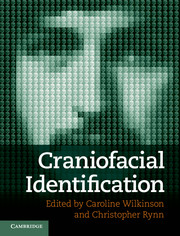Book contents
- Frontmatter
- Contents
- Contributors
- Part I Identification of the Living
- Chapter 1 Familiar face recognition
- Chapter 2 Unfamiliar face recognition
- Chapter 3 EFIT-V
- Chapter 4 Facial recall and computer composites
- Chapter 5 Facial ageing
- Chapter 6 Age progression and regression
- Chapter 7 Computer-assisted age progression
- Chapter 8 Facial recognition from identification parades
- Chapter 9 Virtual human identification line-ups
- Chapter 10 Computer-generated face models
- Chapter 11 Recognising and learning faces in motion
- Chapter 12 Facial image comparison
- Chapter 13 Three-dimensional facial imaging
- Part II Identification of the Dead
- Index
- Plate Section
- References
Chapter 9 - Virtual human identification line-ups
Published online by Cambridge University Press: 05 May 2012
- Frontmatter
- Contents
- Contributors
- Part I Identification of the Living
- Chapter 1 Familiar face recognition
- Chapter 2 Unfamiliar face recognition
- Chapter 3 EFIT-V
- Chapter 4 Facial recall and computer composites
- Chapter 5 Facial ageing
- Chapter 6 Age progression and regression
- Chapter 7 Computer-assisted age progression
- Chapter 8 Facial recognition from identification parades
- Chapter 9 Virtual human identification line-ups
- Chapter 10 Computer-generated face models
- Chapter 11 Recognising and learning faces in motion
- Chapter 12 Facial image comparison
- Chapter 13 Three-dimensional facial imaging
- Part II Identification of the Dead
- Index
- Plate Section
- References
Summary
Introduction
The legal system has long relied on eyewitnesses of crimes to help identify and prosecute criminals. Eyewitness identification is arguably one of the most influential forms of evidence that can be presented to a judge or jury. The general idea behind eyewitness identification is that a witness to a crime, whether a victim or bystander, can later establish the perpetrator’s identity. It is assumed that if the witness had a good view of the crime and was paying attention to the physical characteristics of the perpetrator, then the witness’s memory will be a valid indicator of identity, particularly if the witness is certain about his or her identification. In this chapter, we will examine the current state of traditional eyewitness identification line-ups, present an overview of a recently proposed idea to utilise virtual environments and virtual humans in identification line-ups, and finally present a comprehensive review of how virtual human identification line-ups may offer advantages over traditional line-ups.
Traditional eyewitness identification line-ups
According to Wells and Olson (2003), a line-up is a procedure in which a criminal suspect (or a photograph of the suspect) is placed among other people (live line-up) or photographs (photo array), commonly referred to as fillers or foils. Line-ups and photo arrays typically contain at least six individuals or photographs, comprised of the suspect and at least five fillers. The individuals or photographs are then presented to an eyewitness, either sequentially or simultaneously, for identification. Eyewitness identification evidence is powerful; more than 75 000 people each year become criminal defendants on the basis of eyewitness identifications (National Science Foundation, 1997). Although eyewitness identification is one of the most compelling types of evidence to which a jury or judge is exposed, experimental research (Wells, 1993; Wells and Loftus, 2003) and cases of DNA exoneration (Wells and Quinlivan, 2009) have prompted scholars and practitioners to question the accuracy, confidence levels and procedures of eyewitness identification.
- Type
- Chapter
- Information
- Craniofacial Identification , pp. 101 - 114Publisher: Cambridge University PressPrint publication year: 2012



